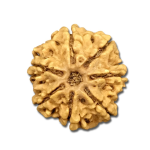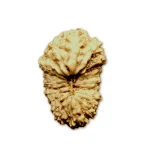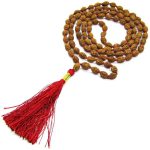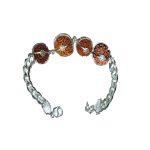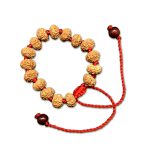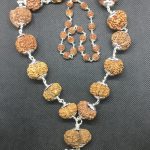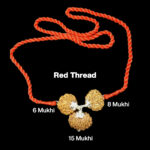Rudraksha – What is it?
Rudraksha Beads

No single tree is as rich with scriptural references, spiritual myths and legends as the Rudraksha. Its beads have long been sought for their supposed medicinal and magical properties. The word Rudraksha (botanical name: Elaeocarpus Ganitrus) is derived from the words Rudra (Shiva) and aksha (eyes). Ancient spiritual texts like the Shiv Purana and the Devi Bhagwatam are replete with the numerous therapeutic properties and the spiritual significance of these herbal beads. The various colors, shapes, sizes and the number of cuts, called mukhis, determine the value of the bead. This helps to determine its significance in treating different ailments.
Rudra Centre has over the years developed Rudraksha Ratna Science Therapy which is a scientific way to tap the power of these beads. Rudraksha beads work on different chakras of the body and when strung according to this therapy, they start cleansing the chakras in a very short duration. From regulating blood pressure, to treating skin problems, backache, headache, psychiatric cases and providing relief from tension, phobia and insomnia and giving success in business, educations and relationships they have an admirable success rate. A typical session involves the therapist to have one to one session with the client in which the problems are discussed and root cause identified and Rudraksha beads suggested. Once a client wears the beads, he starts experiencing positive changes in a week’s time and full effects in a month’s time.
With the development of modern science, many scientists have carried research for evidence to support the ancient beliefs about the Rudraksha. Their findings and research has validated and confirmed the divine power of Rudraksha beads. Individuals from every walk of life irrespective of caste, creed, religion, nationality or gender can use the divine Rudraksha to attain maximum spiritual, physical and material benefits.
Rudraksha Beads range from 1 Mukhi to 21 Mukhi, each bead capable of aligning our mind and the energy around us to specific outcomes in health, happiness, spiritual upliftment, prosperity, creativity, intuitive ability, material fulfilment, family harmony, attraction, self- empowerment and a fearless life.
Rudraksha Found In Nature: Seeds, Leaves and Trees
Scientifically Rudraksha plant Elaeocarpus is a large genius of broad-leaved evergreen trees. The trees are almost 50ft to 200ft in height growing in the North Indian River Plain of the Himalayas to South-East Asia, Nepal and Indonesia. All trees bear white flowers with fringed petals that develop into drupaceous fruit resembling olive. The main trunks of the trees are cylindrical with the section being circular. Bark is grayish white and rough in texture with small vertical lenticels and narrow horizontal furrows. The branches of Rudraksha spread in all directions are such a way that when growing in natural habitat, the crown takes the shape of a pyramid. Rudraksha is basically grown in subtropical climatic region with temperature ranges from 25 to 30 degree centigrade. Read More

Once the seeds are planted, they grow into trees (15 to 16 years) that start giving fruits similar to ‘Blueberries’. In its original form, a Rudraksha is this fruit with a blue husk covering the seed (bead). The blue color is not caused by pigmentation but evolves as the trees grow, bearing the fruits in around 3-4 years. The fruit is kept in water for a number of days and then Rudraksha is taken out after peeling off the pulp. Rudraksha beads contain 50.031 % carbon, 0.95% nitrogen, 17.897% hydrogen and 30.53% oxygen. The tree has nearly 36 sister species, including Rudraksha. Rudraksha, being a plant, is specially worn without contact with metal; thus on a cord or thong rather than a chain. In the single tree Rudraksha beads comes in all different mukhis (faces) at the same time but higher Mukhis or faces are very rare to find where most of Rudraksha beads are Five Mukhi. The beads come in seasonal pattern every year around mid-August to mid-October. Read More

Rudraksha trees (scientific name – Elaeocarpus Ganitrus, English name – Utrasum Bead Tree, Indonesian name – Ganitri or Jenitri Tree) are mainly found in Nepal, South East Asia in Java (Indonesia), Malaysia, Thailand and also in India, Burma and other countries. Amongst all, Rudraksha beads from trees found at the foothill of Himalayas above sea-level 2000m in Nepal are regarded as the best. A Rudraksha tree requires 10-12 years to grow fully and bear Rudraksha fruits, a fully grown Rudraksha tree has large leaves and can grow up to a height of 50 to 200 feets. Cold climate as well as the soil quality plays an important part in the growth of a Rudraksha tree. Rudraksha tree first blooms white flowers from which round shape Rudraksha fruits are obtained. The fruit of Rudraksh tree is not very tasty to eat and has a sour taste. The green fruits fall on their own after ripening when it becomes blue colored berry like fruit. When the upper coating is dried and peeled one will get the hard Rudraksha. One may plant a small Rudraksha tree at their home garden. Read More
Science of Rudraksha: Modern Research and Studies
With the development of modern science, scientists researched for evidences that support the ancient belief on the significance of Rudraksha. The merits of Rudraksha were evidenced in the late 1960s by a group of scientists lead by Dr. Suhas Rai, Institute of Technology University in Banaras India. Dr. Rai’s research boosted an ancient belief that, as scripted in the scriptures, the inner structure of Rudraksha beads undeniably contained subtle electromagnetic atoms that had an impact on the body.
Read More
Rudraksha Beads for Various Ailments
Wearing the sacred Rudraksha beads brings one to the alpha state of present moment living. Since these beads are not man-made, they have indeed impact on the human body. Holistic Healer Neeta Singhal with her decade-long research on Rudraksha beads has devised Rudraksha Ratna Science Therapy (RRST) that incorporates the use of Rudraksha and Gemstones for better health. The RRST therapy combined with the ancient Vedic Knowledge and modern scientific proof confirm the effectiveness of wearing Rudraksha beads. Rudraksha Ratna Science Therapy (RRST) is a scientific method based on the Vedic Puranas, Upanishads and Neeta Singhal’s research, knowledge and experience of Aura- Chakra Therapy.
Read More
Rudraksha in Vedic scriptures: Quotes From Ancient Texts
From the Vedic and scriptural point of view, the Sanskrit word ‘Rudraksha’ symbolizes Rudra (Lord Shiva). The root word rud means ‘to wail’; Rudra means the one who wails, howls or roars. Another derivation mentions rud which also means in Sanskrit ‘being red’ leading to ‘red, intense, and brilliant’. The English word ‘ruddy’ is derived from old English rudig, rud which means ‘red’.
The Rig Veda mentions (Rukh draavayathi iti rudraha). Rukha means ‘grief, distress or anguish’. Draavayathi means ‘to eradicate’, ‘iti’ means ‘that’ or ‘who’, and Rudra means another name of Shiva. It means Shiva who eradicates miseries or grief. ‘Rudra’ is Lord Shiva and ‘Aksha’ means tears. Therefore, Rudraksha means tears of Shiva. Lord Shiva is the ardent user and admirer of Rudraksha. In fact both cannot be separated.
(Rukh draavayathi iti rudraha). Rukha means ‘grief, distress or anguish’. Draavayathi means ‘to eradicate’, ‘iti’ means ‘that’ or ‘who’, and Rudra means another name of Shiva. It means Shiva who eradicates miseries or grief. ‘Rudra’ is Lord Shiva and ‘Aksha’ means tears. Therefore, Rudraksha means tears of Shiva. Lord Shiva is the ardent user and admirer of Rudraksha. In fact both cannot be separated.

A person who wears all Rudraksha becomes become Me I
So, one should attempt from all levels to wear the divine Rudraksha II
-Shiva in the Padma Purana

Even Rudra attained Rudrahood only after wearing Rudraksha beads I
Saints achieve the ultimate truth and Brahma attains Brahamatav.
Thus there is nothing higher than wearing Rudraksha beads in this world II
-Padma Purana

Just like Vishnu amongst men, Surya amongst all the planets I
Ganga among rivers, Kashyap among human I
Shiva amongst all Gods, Parvati amongst all Goddesses is Highest praised II
Similarly Rudraksha is the Highest amongst All I
Hence there is no Sloka or fast above Rudraksha II
Shrimad Devi Bhagwatam
In the view of Vedas, Rudraksha beads are divine. They have spiritual charge that affects the mind, the body, the senses and the soul. Even devas (gods) of the heavenly planets seek to wear these beads for their numerous benefits.
Before we study the benefits, let’s know more about Mukhis, the faces of Rudraksha beads. The faces are determined by the lines that segment the bead.
Read More


Legends associated with the origin of Rudraksha
Ancient Vedic scriptures talk about different circumstances leading to the creation of “Rudra”. All the epics are centered on Lord Shiva. Lord Shiva is also known by the name “Rudra”. According to Shiva Purana, once Lord Shiva went into deep meditation for a long period for the well-being of all living beings. After waking from the state of meditation, he opened his eyes and instantly tear drops fell on the earth. On reaching the ground, these tear drops took the form of seeds which later grew into Rudraksha trees.
